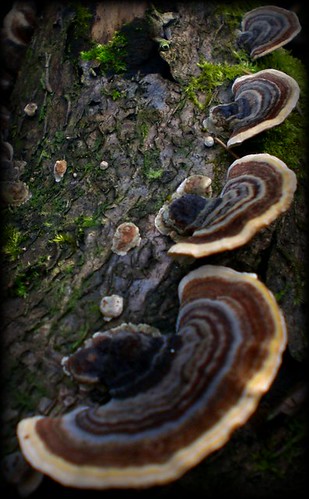Tuesday 25 August 2009
Mushrooms!

I never had much time for mushrooms when I was young; they weren’t particularly exciting to my immature self, they didn’t animate or change colour, and they didn’t seem safe. I can’t say I ever particularly enjoyed eating them either (there is little more offensive to my palate than poorly cooked mushrooms, slimey and crunchy simultaneously, in an eyeball popping sort of way). As I have grown older and more aware of the diverse complexity of our biosphere, I have found myself increasing enamoured of this often overlooked kingdom.
Mushrooms as we commonly recognise them, or toadstools for the more fantastically minded, are part of a vast and ancient kingdom of biology that has existed in some form or another since the dawn of life. Some of the first organisms to colonise land, were members of the kingdom known as Fungi. Classified as Eukaryotic, meaning cells with a nucleus, they are therefore similar on the cellular level to both animals and plants, yet distinct from both, although recently understood to be far more similar to animals than to the plants. The largest single organism known to man by area is a mycelial mat in Eastern Oregon covering 2200 square acres.
Fungi have been described as primary decomposers and molecular disassemblers; they are adept at utilising any available foodstuff, which can essentially be anything organic, and turning it into food. Fungi deconstruct dead and decomposing plant or other organic matter, and by doing so they not only continue their lineage, but return vital minerals and nutrients to the soil and food-chain. Fungi in the form of yeast have been used to ferment bread and beer for millennia, and similarly moulds have been used in various combinations with bacteria to produce an abundance of cheeses, from fermented milk curds. They can also generate complex, novel by-products, some useful: bacteriocides, immuno-modulators and profound psychoactive compounds (this meta-mind is a whole topic of discussion in and of itself) , and some deadly, and many we still don’t understand.
Many fungi are also symbiotic with various plant species, typically in the form of what is called a mycorrhizal association. These fungi form an alliance (non-moral) with the roots of a plant and provide various micro-nutrients and mineral salts to that plant, those that it would otherwise struggle to absorb, and in return the fungi extracts certain nutrients from the root system. This relationship is particularly tangible in healthy forest systems at this time of year, as the mushrooms begin to shoot up around the base of trees, particularly the deciduous here in UK. The actual organism exists underground: the mycelium, in association with whatever it is using as its food-source, or whatever plant species it has an affinity with, the mushroom being only a yearly sexual expression, a fruiting body, the tip of the proverbial iceberg. As a result of these relationships, one can measure, to an extent, the ecological age of a natural system by the diversity of is mushroom species and in turn its ecological complexity and hence relative health.
Another measure of health that can be construed from a diverse and healthy fungal population is our own. In our hyper-intensive farming monocultures, the mycorrhizal associations with crop systems have been drastically over-looked, originally through ignorance, but now through habit and managed indifference. The constant spraying of fungicides to counter parasitical fungal crop infections has had a devastating impact on the fungal diversity of the soil. Ironically this means that the crops are far less robust in themselves, and more fungicides and insecticides etc. are required to sustain them. Consequently the crops have also become increasingly deficit in minerals and micro-nutrients, a problem compounded by the fact the land is never left to fallow. It is no wonder that mineral and (the under-acknowledged) micro-nutrient levels are waning drastically in our common foods, and that we are beginning to find that this is to our detriment.
Anyway, back to mushrooms; now is the time to go and have a look at them, the plants are dying back and the rains are coming in, so the fungi are in their prime. Not only can they be beautiful in themselves, but the cycle of symbiosis that they are a part of is profound, and an excellent base metaphor for anyone that appreciates ecological diversity and its worth (nay - vital importance), or inclined towards emphasising the paradigm of collaboration over competition. They may even be growing on your lawn.
Paul Stamets: 6 Ways Mushrooms Can Save The World
(an excellent, informative and optimistic video, that every Evolver should watch, and the title is not as hyperbolic as one might think)
Mycorruption's mushroom photos
Medicinal Mushroom facts from wikipedia
Subscribe to:
Posts (Atom)




